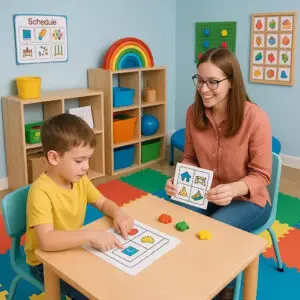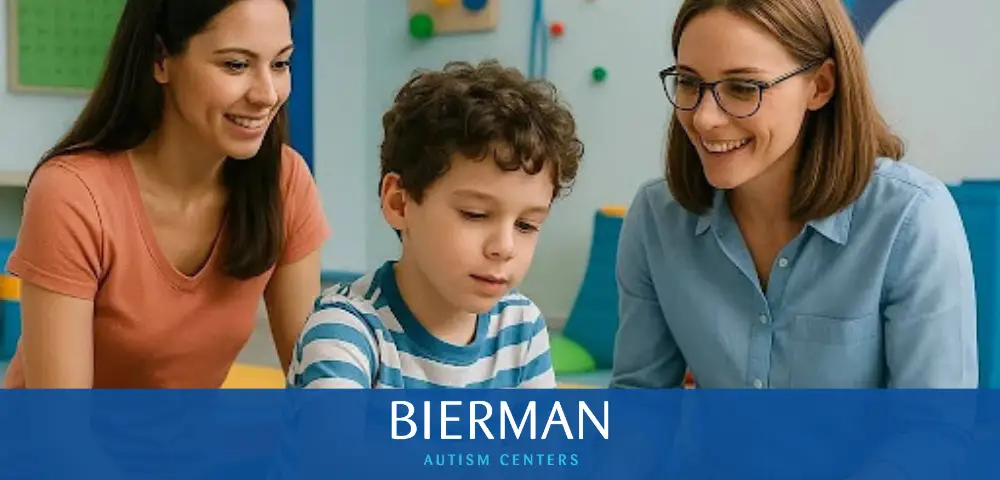Parents often wonder about the difference between ASD vs autism. Do the terms mean the same thing? What does each term imply, and why does it matter?
The truth is, many parents feel confused by these terms, but don’t worry! In this guide, we’re going to clear up the meaning of ASD vs autism so you can navigate your child’s journey with greater confidence.
Let’s jump right in.
ASD vs. Autism: The Simple Truth Behind the Terms
Here’s what every parent needs to know: ASD and autism are one in the same. Autism spectrum disorder (ASD) is the official medical term used in diagnoses today, while “autism” is the commonly used shorthand that most people recognize and understand.
Think of it like this. When someone says they have “diabetes,” they might technically have “diabetes mellitus type 2,” but both terms describe the same diagnosis. Similarly, when professionals discuss ASD vs autism, they’re using different levels of formality for the same diagnosis. Both ASD and autism are classified as neurodevelopmental disorders in major diagnostic manuals.
It’s also important to note that ASD is grouped with other neurodevelopmental disorders in the DSM-5, reflecting the evolution of diagnostic categories.
What ASD Actually Means
ASD is the umbrella term that encompasses what we understand as autism today. According to the most recent data from the Centers for Disease Control and Prevention, approximately 1 in 31 children aged 8 years were identified with ASD in 2022. This represents a significant increase in identification and understanding of the disorder.
The “spectrum” aspect of ASD is important because it acknowledges that autism presents very differently from child to child. Each child is unique in his or her own way, and the term ASD seeks to celebrate these independent individualities. It also represents the three different levels of severity of autism, with the levels representing the “spectrum” of symptoms and severity of symptoms that can present with ASD.
When and Why We Say ‘Autism’
Many parents find that saying “autism” feels more natural in everyday conversations. When you’re talking to family members, teachers, or friends, “autism” is often more immediately understood than the full medical term. Both terms are correct and acceptable to use.
Your child’s diagnostic paperwork will likely use “autism spectrum disorder” or “ASD,” but don’t worry if you prefer to say “autism” in daily life. What matters most is that your child receives the individual support and care they need to thrive.
Why the ASD vs. Autism Terminology Changed: A Brief History
Understanding why these terms evolved can help reduce confusion. Before 2013, there were several separate diagnoses including Autistic Disorder, Asperger’s Syndrome, and Pervasive Developmental Disorder-Not Otherwise Specified (PDD-NOS). Asperger syndrome and childhood disintegrative disorder were also previously considered separate disorders. Parents often felt confused about which category their child fit into.
Asperger’s syndrome was once recognized as a distinct diagnosis before being merged into ASD in the DSM-5. Some practitioners even used their own diagnostic criteria before the DSM-5 unified these categories, moving towards a more inclusive and standardized understanding of autism-related disorders.
The 2013 DSM-5 Update: What Changed for Families
The American Psychiatric Association simplified these categories into one comprehensive diagnosis: ASD. This change brought several important benefits:
- Eliminated confusion between similar but separate diagnoses
- Recognized that autism exists on a spectrum of support needs
- Improved access to services by using one unified term
- Better reflected the reality that autism symptoms vary widely between individuals
Additionally, the DSM-5 introduced social communication disorder as a separate diagnosis for individuals who have social communication difficulties but do not meet the criteria for ASD.
What This Means for a Child with an ASD vs. Autism Diagnosis?
First and foremost, the specific wording matters less than understanding your child’s individual needs. In clinical practice, healthcare providers use standardized criteria to ensure accurate diagnosis and appropriate support. Whether the report says “ASD” or “autism,” you’re looking at the same diagnosis with the same potential for growth and development.

Recent research published in JAMA Psychiatry shows that 72% of children receiving ABA therapy demonstrated meaningful skill gains, highlighting the importance of early intervention regardless of terminology used.
Your Child’s Diagnosis Document: What to Expect
Your child’s official diagnosis will likely include ASD along with a specification of support level (requiring support, substantial support, or very substantial support). This information helps determine appropriate services to help boost your child’s confidence and help them blossom in their daily life.
At Bierman Autism Centers, testing and diagnosis is supported by pediatricians, psychologists, and developmental specialists. During the diagnosis evaluation, Bierman’s experts use a range of gold-standard screening tools, such as ADOS-2 and CARS. Assessments are calibrated based on your child’s age and unique needs. The results of the assessment will guide the specialists to the correct support level and path forward for your child.
Don’t be surprised if different professionals use varying terms. Your child’s pediatrician might say “autism,” while the school district uses “ASD.” Both are referring to the same disorder.
What Are the Characteristics of ASD vs. Autism?
According to the Diagnostic and Statistical Manual (DSM-5), ASD is a developmental diagnosis that affects how a person communicates, interacts socially, and behaves. The diagnostic criteria for ASD include persistent interferences in social communication and social interaction, as well as restricted and repetitive behaviors.
When people refer to “autism,” they’re usually talking about the same set of characteristics that define ASD. These can include interferences in forming relationships, understanding social cues, and engaging in repetitive behaviors or routines.
It’s important to remember that autism is not a separate diagnosis from ASD. Instead, “autism” is a commonly used term to describe the specific features and behaviors outlined in the official diagnostic criteria for autism spectrum disorder. Whether you hear “ASD,” “autism spectrum,” or “spectrum disorder,” they all refer to the same neurodevelopmental disorder described in the statistical manual used by healthcare professionals.
Understanding the Spectrum: Signs Parents May Notice
As a parent, you may notice early signs of ASD in your child’s daily life. Some of the most common indicators include difficulty making or maintaining eye contact, trouble understanding social cues, and interfering behaviors when it comes to building relationships. Children with ASD may also experience verbal and nonverbal communication interferences, which can show up as delayed speech development, limited use of gestures, or interferences interpreting body language.
Repetitive behaviors are another indicator of autism. These can include:
- Hand flapping
- Rocking
- Repeating certain phrases
- Insisting on specific routines
Many children with autism also become intensely focused on particular topics or activities. Sensory sensitivities are common as well, such as sound, light, and texture sensitivity.
Keep in mind that early support and autism therapy services can help a child build essential skills for play, social interaction, and communication, setting the stage for exceptional future growth.
Support Options for ASD and Autism
Evidence-based interventions like Applied Behavior Analysis (ABA) focus on your child’s individual needs rather than diagnostic terminology. ABA therapy, such as the sessions provided at Bierman Autism Centers, is a proven method to help kids develop essential life skills and reduce interfering behaviors.

Behavioral interventions, like those based on positive reinforcement and structured routines, are a key part of learning. Ongoing support helps children adapt better to their day-to-day lives, all while encouraging fun play in a safe, exciting environment.
For families seeking comprehensive information about early signs and interventions, Autism Speaks provides valuable resources and next steps for families.
Insurance and Services: Using the Right Terms
When working with insurance companies or school districts, consistency in terminology can be helpful. Here’s what to keep in mind:
- Use “autism spectrum disorder” or “ASD” in official documentation
- Reference your child’s specific diagnosis code (usually F84.0)
- Keep copies of all diagnostic reports that use official terminology
Finding ABA Therapy: What to Look For
Quality ABA providers understand that ASD vs autism terminology doesn’t change your child’s needs. When evaluating potential therapy providers, focus on their approach to individualized treatment rather than which term they use.
Look for centers that:
- Conduct comprehensive assessments of your child’s unique needs
- Develop tailored sessions and plans for your child
- Include family training and support
At Bierman Autism Centers, our ABA therapy program is based on research-backed and proven methods that emphasize naturalistic teaching and play-based learning. Each of our ABA therapists focus on empowering children with the tools they need to thrive in various aspects of their lives.
To learn more about the benefits of ABA for children and how to find a Bierman Autism Centers near you, contact us directly.
Moving Forward: Your Next Steps After Understanding ASD vs. Autism
Now that you understand the relationship between ASD and autism, you can focus on what truly matters: supporting your child’s development and celebrating their unique strengths. The terminology debate becomes less important when you’re equipped with knowledge and connected to the right resources.
Building Your Support Team with Confidence
As you move forward, focus on building a team of professionals who understand your child’s needs and support your family’s goals. This might include ABA therapists, speech pathologists, occupational therapists, and educators who work together to help your child thrive.
The most important thing you can do is trust your instincts as a parent while staying open to professional guidance. Your child’s diagnosis, whether written as ASD or autism, is just the beginning of a journey filled with possibilities for growth, learning, and joy.
Ready to Take the Next Step? Connect with Bierman Autism Centers
Understanding the difference between ASD vs autism is just the beginning. At Bierman Autism Centers, we believe every child deserves personalized, evidence-based care that celebrates their unique potential. Our team of dedicated professionals works closely with families to create individualized treatment plans that promote meaningful progress and lasting skills.
We’re here to support your family’s journey with compassion, expertise, and fun! Our comprehensive approach combines the latest research with a deep understanding of each child’s individual needs, creating an environment where progress and possibilities flourish.
Contact us today or read our exciting success stories here to learn how we can support your child’s development and help your family navigate this journey with confidence.
Frequently Asked Questions
Are ASD and autism the same thing?
Yes, ASD and autism refer to the same diagnosis. Autism spectrum disorder (ASD) is the official medical term used in diagnoses today, while “autism” is the commonly used shorthand that most people recognize and understand.
Why did the terminology change from separate diagnoses to Autism Spectrum Disorder?
In 2013, the American Psychiatric Association simplified multiple separate diagnoses (like Asperger’s Syndrome and PDD-NOS) into one comprehensive diagnosis: Autism Spectrum Disorder. This change eliminated confusion between similar diagnoses and better reflected that autism symptoms vary widely between individuals.
What does “spectrum” in ASD mean?
“Spectrum” acknowledges that autism presents differently from child to child. Each child is a unique, beautiful individual who requires their own tailored journey to growth and development.
Which term should I use when talking about my child’s diagnosis?
Both terms are correct and acceptable to use. Your child’s diagnostic paperwork will typically use “ASD,” but saying “autism” in daily conversations is perfectly fine and often more easily understood.
What terminology should I use for insurance and school services?
Use “ASD” in official documentation for consistency. Reference your child’s specific diagnosis code (usually F84.0) and keep copies of all diagnostic reports that use official terminology.
What information will be included in my child’s official diagnosis?
Your child’s official diagnosis will likely include “ASD” along with a specification of support level (requiring support, substantial support, or very substantial support). This information helps determine appropriate services for your child.



